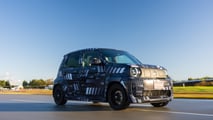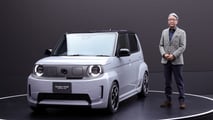
Coming off a downhill back-of-the-track twisty at the rear of Honda’s R&D proving grounds in Tochigi, Japan, I encountered a slight uphill stretch. It was my second lap, so the engineer co-driver riding shotgun had already reached over and engaged the “Boost Mode” button on the tiny steering wheel, but the Honda Super-One still struggled a bit to mount the mound.
I clicked a few times on the wheel’s left paddle. The ersatz seven-speed automatic transmission simulator downshifted several pseudo “gears,” enacting a bit of fake shift shock. The imitation exhaust sound whinnied a bit higher. The synthetic numberless “tach” climbed, nearly bumping off the faux “fuel cutoff” limiter. But there was nothing spurious about the joy I felt as the rectilinear little two-box zipped its way up and around the turn, its behavior every bit as exuberant as it had been on every other part of the course.
Gallery: Honda Super One Prototype Drive







Introduced to the public at the Goodwood Festival of Speed this past summer, shown off as a prototype at the Japan Mobility Show just a few days before my drive, and slated for production as a 2026 model, the Super-One is the third model in Honda’s contemporary EV series. While the N Van EV’s mission is labeled as “Commercial” by the automaker, and the N-One’s is “Affordable,” the Super-ONE is being developed under the rubric of “Fun.” This designation is correct.
Though it is based entirely upon the Honda N-One E electric Kei Car, the Super-One is not officially a Kei Car itself. Its box flared front and rear fenders, swollen by 50 mm (about two inches) at each corner, are enough to discharge it dishonorably from this diminutive category. But Kei’s loss is our gain, as its removal exempts it from the class’ output limitations, which are voluntarily set by the local OEMs at about 63 hp. Exactly how much power is the Super’s under-seat battery pack providing to its front wheels? Good question. When I asked for a precise figure, the Honda engineer in charge of the program smiled and said, simply, “More.”
Speaking of wheels, instead of the diminutive 14-inchers and 155/65 section tires, with which its more plebian brethren are shod, the Super-One rolls on upsized 16s, wrapped in meaty 205/45 performance rubber. This is a serious upgrade. But while I didn’t have a chance to sample the base EV, when pegging this little beast around our makeshift section of Tochigi, it was clear that these donut bites had their limitations. The Super-One is tall and short and quick to oversteer. Still, the edges of its grip mate well with the edges of its motor’s capabilities. It is clearly a car that is meant to be driven flat out, and best enjoyed at its margins.

Nothing in the interior will get in the way of this revelry. In part, because there is very little in the interior whatsoever. It features the most basic Honda bits—a tiny screen in the instrument panel, another tablet-sized one affixed to the center of the dash, some analog HVAC controls, and the brand’s standard pushbutton transmission controls, along with familiar power window, mirror, and door switches in the armrest—but nothing you don’t need. Beneficially, given its enhanced limits, it also includes a pair of heavily bolstered charcoal/dolphin/royal blue Honda liveried front seats, which are sueded cloth and suitably grippy. The overall aesthetic is pared back to a borderline-Slate modality. But given the scale, feature, and price bloat that has afflicted the American car market in the 2020s, this honesty was refreshing.
While lingering in Japan, I’m working on another story for you Insiders that will explain in detail Honda’s electrification plans for the American market, including its consideration of affordable EVs, so stay tuned here for that. But I can reveal now that the Super-One is not included in these schemes.

Gallery: Honda Super One Prototype EV







This adorable little squeaker—which is literally four-and-a-quarter feet shorter than our 2025 Honda Civic sedan—likely wouldn’t pass our stringent crash regulations, nor would it be capable of passing anything on an American highway. And, as Honda engineers told me, it’s currently being built only for right-hand-drive markets in the UK and Asia. So, our current, confounding, erratic, and challenging automotive landscape is one hill that the Super-ONE will not be climbing.
Brett Berk is a freelance automotive writer based in New York. He has driven and reviewed thousands of cars for Car and Driver and Road & Track, where he is a contributing editor. He has also written for Architectural Digest, Billboard, ELLE Decor, Esquire, GQ, Travel + Leisure and Vanity Fair.
Click here to see all articles with lists of the best EVs






